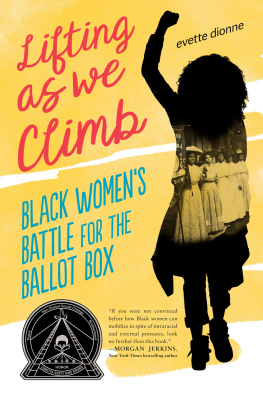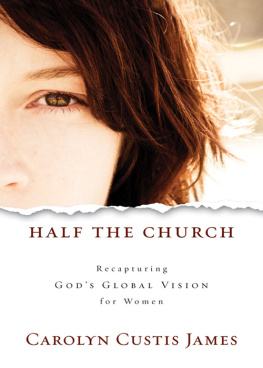Joanna P. Moore
Charles H. Mason
Acknowledgments
I have many, many people to express my gratitude to for making this book possible. Without their help, whether financial, moral, academic, or otherwise, this book would not exist.
I owe a large debt to two agencies whose generosity funded this project. The Center for the Study of Religion at Princeton University, headed by Robert Wuthnow, granted me a postdoctoral fellowship in 2001-2. Thanks to Bob, Anita Kline, and Marie Griffith (associate director of the center at the time) for making my time at Princeton University productive and crucial to the direction of the book (despite 9/11 and anthrax!). The Louisville Institute, with Jim Lewis as executive director, and the board of the Louisville Institute graciously granted me a First Book Grant Program for Minority Scholars in 2003-4 that also helped tremendously in the completion of this book. Jims graciousness and the input of board members helped in figuring out the so what? questions that are often most important to a book project.
Two other projects I was involved with during writing this book provided me with both the camaraderie and the theoretical framework that made this book possible. The Women and Religion in the African Diaspora Project, funded by the Ford Foundation was tremendously supportive. Leaders Marie Griffith and Barbara Savage, and the wrad crew, were my homies on this long journey, and I appreciate their friendship and support. I am grateful for their advice, direction, and friendship. The History of American Christian Practice Project, funded by the Lilly Foundation and led by Laurie Maffly-Kipp, Leigh Schmidt, and Mark Valeri, gave me a space to work out the books theoretical kinks. The much-needed working vacations we took over the span of the projects and the friendships that were built were of great support to me, especially the discovery of Lapis!
The opportunity to engage in these various grants and projects came about through the care and generosity of the Department of Theological Studies at Loyola Marymount University. It is a rare faculty that does its best to support junior scholars, and though I am no longer with them, their support was much valued and appreciated, and shows in this book.
To the woman who had a vision of what this book could be, my editor, Elaine Maisner, I give thanks from the bottom of my heart for having enormous patience with me! She is simply the best. I am grateful to her for all of her efforts and support. I thank Mary Caviness, manuscript editor, for her patience and hard work on making this book sing. A special thank you also to Ruth Homrighaus, whose assistance with this manuscript in the initial stages was vital to maintaining my sanity!
To those within the Church of God in Christ who welcomed me into their homes, basements, and lives I owe profound thanks. I could not have completed this book without their assistance and input. Sherry Sherrod DuPree welcomed me into her home and let me accompany her on interviews. What she has done to prevent Pentecostal history from crumbling by the wayside has been inspirational. Her private collection and the collection given to the Shomburg Library in New York City provided much of the foundational work of this book. Thanks also go to Glenda Goodson, who provided me many of the pictures and convocation books mentioned, for her assistance and companionship on the road! Raynard Smith, founder and leader of COGIC scholars, graciously introduced me to many of the Saints on the East Coast, including Elder Gorham, who were instrumental in putting together some of the stories in the book. One of those Saints, Juanita Faulkner, was a source of great stories and insights, and I thank her very much for sharing herself with me. A special thanks also to Mother Phyllis Barnett in Los Angeles, Emma Clark, and state supervisor Mother Martha Parker of Nebraska, who also were of great assistance to me during the research and writing of this book. I could not have hoped to dress so well until Mother Barnett showed me how to shop!
There is one member of COGIC, however, who I must single out as the most important source for almost everything in this book: Dr. David Daniels III. David and I have talked COGIC from Memphis, Tennessee, to Sao Paulo, Brazil, and every place imaginable in between! Without his vast knowledge of COGIC, this book could not have been written. I am profoundly grateful for his friendship and sharing his knowledge with me. I hope that the book is worthy of the time he spent in helping me to write and research the history of COGIC women.
Archivists also helped very much in piecing this history together. Several archives should be singled out for their special help and assistance: the American Baptist Historical Society, and specifically Deborah Van Broekhoven, Betty Layton, and Betsy Dunbar for their friendship and assistance. The staff of the Flower Pentecostal Heritage Center under Wayne Warners leadership were of great help in the initial stages of the project. The staff at the Schomburg Library in New York and the Chicago Historical Society were also helpful. Finally, the archivists at the Moorland Spingarn Archives at Howard University were helpful in digging up a treasure trove of the COGIC newspaper The Whole Truth and other materials helpful to this project.
Many of my colleagues in the academic community proved to be excellent conversation partners, listening ears, and sources of encouragement when I felt overwhelmed or about to throw in the towel. They include Judith Weisenfeld, Lewis Baldwin, Victor Anderson, Darren Sherkat, Mel Robeck, Tim Matovina, Diane Winston, Heather Curtis, Dianne Glave, Katie Lofton, Leslie Callahan, Tisa Wenger, Daniel Ramirez, Suzette Lemrow, Kirsten Andresen, Jeff Williams, Paul Wilhelm, Barbara Holmes, Jane Crawford, Michelle Gonzalez Maldonado, James Pratt, Deidre Crumbley, Jean-Daniel Pluss, Walter Hollenweger, Fred Harris, Eric Williams, Suzanne OBrien, Tim Kitchen, and Jack Sakmar. They all had my back, and I thank them for it.
To my parents, Jessie Butler and Willa Butler, and my sisters, Stacy, Kamala, and Keitha, I thank for their love and support during this time. Now I can talk about something else!








